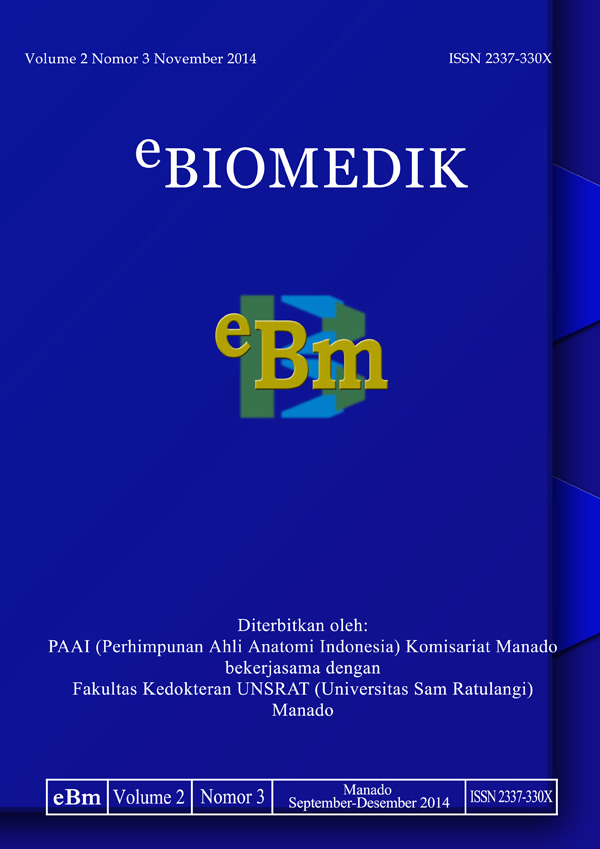GAMBARAN PROSES RADANG LUKA POSTMORTEM PADA HEWAN COBA
DOI:
https://doi.org/10.35790/ebm.v2i3.5899Abstract
Abstract: Skin is the largest and heaviest organ in human body. Its role as a barrier and its location at the surface of human body make it susceptible to trauma which in consequence to wound formation. Human body responses to wound by initiating wound healing process. The fundamental aspect of this process consists of four phases: inflammation, initiation, proliferation, and remodeling. In order to obtain sucessfull wound healing all four phases must occur in a proper sequence and a time frame. Several factors have been known to interfere one or more of these phases. In postmortem condition, wound healing can still occur but the process is different compared to those in antemortem condition. A domestic pig was used on account of the similarity in skin structure and histophysiology with human being to observe the inflammatory process in postmortem wounds. This was an experimental descriptive research. Cut wounds were made at the back of the postmortem pig then skin tissues were taken and reserved in series of time to observe histological features of wound healing process. The results showed that an increase of cells’ number in dermis layer of the skin was observed 15 minutes after the cut wounds. The increase of cells’ number in the first wounds reached its peak at 150 minutes postmortem, meanwhile the increase of cells’ number in second wounds reached its peak at 45 minutes postmortem, 90 minutes after the cut wounds were made. Moreover, the increase of cells’number could be observed until 3 hours postmortem. It was concluded that the inflammatory process of wound healing observed by increases of cells’ number still occured postmortem for a certain time.
Keywords: Inflammatory process, postmortem, wound.
Â
Â
Abstrak: Kulit merupakan organ terbesar dan terberat dari tubuh manusia. Keberadaannya yang membungkus seluruh permukaan tubuh sebagai fungsi proteksi menyebabkan kulit rentan terhadap trauma dan terjadinya luka. Ketika terjadi luka, tubuh manusia akan merespon dengan memulai proses penyembuhan luka. Secara umum, proses penyembuhan luka terdiri dari empat fase, yaitu fase inflamasi, inisiasi, proliferasi dan remodeling. Untuk terjadi penyembuhan luka dengan baik, fase penyembuhan luka ini harus berlangsung dengan urutan dan waktu yang tepat. Banyak faktor yang dapat mengganggu satu atau lebih fase ini. Dalam keadaan postmortem, penyembuhan luka masih dapat berlangsung, namun proses yang terjadi berbeda dengan penyembuhan luka sebelum kematian. Dalam penelitian ini digunakan babi domestik sebagai hewan coba karena babi termasuk hewan omnivora dengan struktur dan histofisiologi kulit yang mirip manusia. Penelitian yang dilakukan merupakan jenis penelitian deskriptif eksperimental. Luka sayatan dibuat pada punggung babi setelah mati lalu jaringan kulit diambil dalam beberapa tahapan waktu untuk melihat gambaran histologik sebagai penanda radang dalam proses penyembuhan luka. Hasil penelitian memperlihatkan bahwa peningkatan jumlah sel pada lapisan dermis terlihat sejak 15 menit setelah terjadinya luka. Peningkatan jumlah sel pada luka tahap pertama berlanjut dan memuncak pada 150 menit postmortem. Peningkatan jumlah sel pada luka tahap kedua berlanjut dan memuncak pada 45 menit yang diambil 90 menit setelah pembuatan luka. Proses inflamasi yang dinilai dari peningkatan jumlah sel pada penelitian ini tetap berlangsung sampai 3 jam postmortem. Penelitian ini memperlihatkan bahwa reaksi inflamasi tetap berlangsung normal pada kondisi postmortem untuk suatu tenggang waktu tertentu.
Kata kunci: Inflamasi, luka, postmortem.





